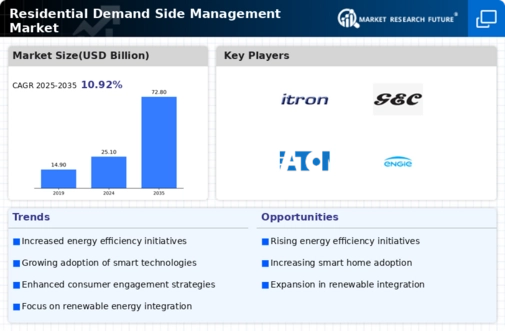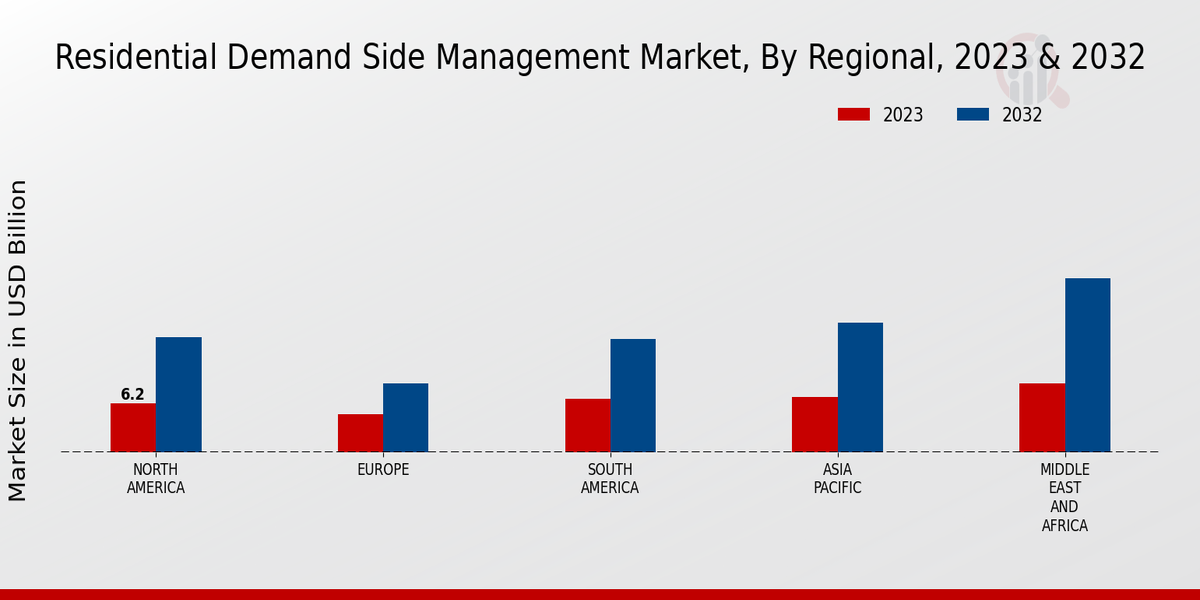Market Growth Projections
The Global Residential Demand Side Management Market Industry is poised for substantial growth, with projections indicating a market size of 25.1 USD Billion in 2024 and an anticipated increase to 72.8 USD Billion by 2035. This growth trajectory suggests a compound annual growth rate of 10.17% from 2025 to 2035, reflecting the increasing adoption of energy-efficient technologies and practices. The market's expansion is driven by various factors, including technological advancements, government incentives, and rising consumer awareness regarding energy efficiency. These dynamics collectively contribute to a robust and evolving market landscape.
Rising Electricity Prices
The persistent rise in electricity prices is a compelling factor driving the Global Residential Demand Side Management Market Industry. As utility rates continue to escalate, consumers are increasingly motivated to seek ways to manage their energy consumption effectively. This trend is particularly evident in regions where electricity costs have surged, prompting homeowners to invest in demand-side management solutions. The market's growth is further supported by the projected compound annual growth rate of 10.17% from 2025 to 2035, indicating a robust response to the economic pressures associated with rising energy costs. This dynamic underscores the urgency for effective energy management strategies.
Growing Energy Efficiency Awareness
The increasing awareness of energy efficiency among consumers is a pivotal driver for the Global Residential Demand Side Management Market Industry. As individuals become more conscious of their energy consumption, they actively seek solutions to reduce their utility bills and carbon footprints. This trend is evidenced by the rising adoption of energy-efficient appliances and smart home technologies. In 2024, the market is projected to reach 25.1 USD Billion, reflecting a growing commitment to sustainable living. The emphasis on energy conservation not only benefits consumers financially but also contributes to broader environmental goals, thereby enhancing the market's appeal.
Government Incentives and Regulations
Government initiatives aimed at promoting energy efficiency play a crucial role in shaping the Global Residential Demand Side Management Market Industry. Various countries have implemented incentives such as tax credits, rebates, and grants to encourage homeowners to adopt energy-saving technologies. For instance, the U.S. Department of Energy has launched programs that facilitate the integration of smart meters and energy management systems. These measures not only stimulate market growth but also align with national energy policies aimed at reducing greenhouse gas emissions. As regulations become more stringent, the demand for residential demand side management solutions is likely to surge.
Technological Advancements in Smart Home Solutions
Technological innovations in smart home solutions are significantly influencing the Global Residential Demand Side Management Market Industry. The proliferation of Internet of Things (IoT) devices enables homeowners to monitor and control their energy usage in real-time. Smart thermostats, energy management systems, and connected appliances are becoming increasingly popular, facilitating more efficient energy consumption. This trend is expected to drive the market's growth, with projections indicating a market size of 72.8 USD Billion by 2035. The integration of artificial intelligence in these systems further enhances their efficiency, providing users with tailored recommendations for energy savings.
Increased Focus on Sustainability and Climate Change
The heightened global focus on sustainability and climate change is a significant driver for the Global Residential Demand Side Management Market Industry. As climate-related concerns gain prominence, consumers are more inclined to adopt energy-efficient practices and technologies. This shift is reflected in the growing demand for renewable energy sources and energy-efficient home improvements. Governments and organizations are increasingly advocating for sustainable living, further propelling the market. The interplay between consumer behavior and environmental responsibility is likely to shape future trends, fostering a more sustainable residential energy landscape.






